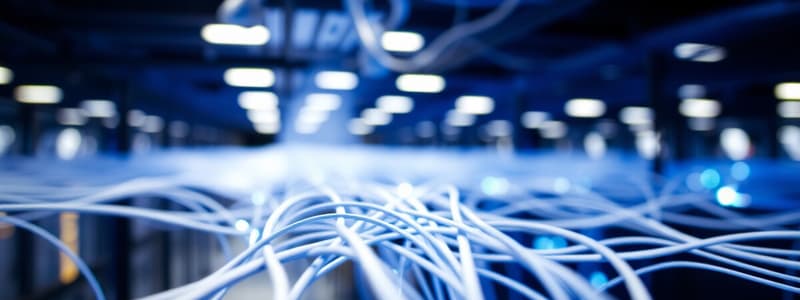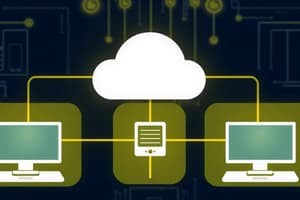Podcast
Questions and Answers
What characterizes synchronous communication?
What characterizes synchronous communication?
- Messages are sent and received at different times.
- Requires both sender and receiver to be active simultaneously. (correct)
- Is only applicable to text-based interactions.
- Occurs when the sender is less available than the receiver.
Which scenario is an example of asynchronous communication?
Which scenario is an example of asynchronous communication?
- A live chat session.
- A video conference with multiple participants.
- Sending an email that the receiver reads later. (correct)
- A phone call between two people.
What does the term 'point-to-point communication' refer to?
What does the term 'point-to-point communication' refer to?
- One sender communicates with one specific receiver. (correct)
- Only occurs in broadcasting formats.
- Distributing information to multiple recipients at once.
- Communication meant for broad audiences.
How does the internet enhance communication?
How does the internet enhance communication?
What is the role of a client in a client/server interaction?
What is the role of a client in a client/server interaction?
What is the primary way that the internet achieves point-to-point communication?
What is the primary way that the internet achieves point-to-point communication?
Which of the following describes how an ISP connection typically functions?
Which of the following describes how an ISP connection typically functions?
In the domain name system (DNS), what is the highest level in the hierarchy?
In the domain name system (DNS), what is the highest level in the hierarchy?
What is the role of the authoritative name server (ANS)?
What is the role of the authoritative name server (ANS)?
How does caching benefit a computer's interaction with the DNS?
How does caching benefit a computer's interaction with the DNS?
What is redundancy in the context of internet server infrastructure?
What is redundancy in the context of internet server infrastructure?
Which method connects computers within a local area network (LAN) to the internet?
Which method connects computers within a local area network (LAN) to the internet?
Which of the following statements about the DNS is true?
Which of the following statements about the DNS is true?
Which protocol is often used for wireless LAN connections?
Which protocol is often used for wireless LAN connections?
What is the primary function of root name servers in DNS?
What is the primary function of root name servers in DNS?
What is the role of client software in communication between computers?
What is the role of client software in communication between computers?
How do cookies help maintain connections with users?
How do cookies help maintain connections with users?
What does an IP packet contain?
What does an IP packet contain?
In the context of networks, what differentiates a WAN from a LAN?
In the context of networks, what differentiates a WAN from a LAN?
What is the function of a switch in a network?
What is the function of a switch in a network?
What does the term 'hops' refer to in networking?
What does the term 'hops' refer to in networking?
What is true about IP packets and their routes?
What is true about IP packets and their routes?
Which of the following is not a characteristic of the Ethernet protocol?
Which of the following is not a characteristic of the Ethernet protocol?
What is required to identify the destination in point-to-point communications?
What is required to identify the destination in point-to-point communications?
During network communications, what is the significance of breaking down data into packets?
During network communications, what is the significance of breaking down data into packets?
What is meant by 'client-side activity' in web interactions?
What is meant by 'client-side activity' in web interactions?
In the TCP/IP model, how can you compare IP packets to postcards?
In the TCP/IP model, how can you compare IP packets to postcards?
What happens when two computers transmit simultaneously on a broadcast medium like Ethernet?
What happens when two computers transmit simultaneously on a broadcast medium like Ethernet?
Flashcards
Synchronous Communication
Synchronous Communication
Communication where both sender and receiver are active at the same time.
Asynchronous Communication
Asynchronous Communication
Communication where sending and receiving happen at different times.
Client/Server Structure
Client/Server Structure
A system where one computer (client) requests services from another computer (server).
Point-to-Point Communication
Point-to-Point Communication
Signup and view all the flashcards
Internet's Communication
Internet's Communication
Signup and view all the flashcards
Client-Server Relationship
Client-Server Relationship
Signup and view all the flashcards
Cookies
Cookies
Signup and view all the flashcards
URL Parameters
URL Parameters
Signup and view all the flashcards
Client-Side Activity
Client-Side Activity
Signup and view all the flashcards
Server-Side Activity
Server-Side Activity
Signup and view all the flashcards
IP Address
IP Address
Signup and view all the flashcards
IP Packet
IP Packet
Signup and view all the flashcards
Payload
Payload
Signup and view all the flashcards
Routing
Routing
Signup and view all the flashcards
Switch
Switch
Signup and view all the flashcards
Router
Router
Signup and view all the flashcards
Hop
Hop
Signup and view all the flashcards
Trace Route
Trace Route
Signup and view all the flashcards
TCP/IP (Transmission Control Protocol/Internet Protocol)
TCP/IP (Transmission Control Protocol/Internet Protocol)
Signup and view all the flashcards
WAN (Wide Area Network)
WAN (Wide Area Network)
Signup and view all the flashcards
LAN (Local Area Network)
LAN (Local Area Network)
Signup and view all the flashcards
Ethernet
Ethernet
Signup and view all the flashcards
Ethernet vs. Internet: How do they differ?
Ethernet vs. Internet: How do they differ?
Signup and view all the flashcards
Internet Service Provider (ISP)
Internet Service Provider (ISP)
Signup and view all the flashcards
Modem: What is it and what does it do?
Modem: What is it and what does it do?
Signup and view all the flashcards
LAN: What is it and what does it offer?
LAN: What is it and what does it offer?
Signup and view all the flashcards
Wireless Network: How does it work?
Wireless Network: How does it work?
Signup and view all the flashcards
Domain Names: Why are they used?
Domain Names: Why are they used?
Signup and view all the flashcards
DNS: What does it do?
DNS: What does it do?
Signup and view all the flashcards
Top-level domains (TLDs): What are they?
Top-level domains (TLDs): What are they?
Signup and view all the flashcards
Authoritative Name Server (ANS): What's its role?
Authoritative Name Server (ANS): What's its role?
Signup and view all the flashcards
Caching: How does it help?
Caching: How does it help?
Signup and view all the flashcards
Study Notes
Networking Basics
-
Communication Types:
- Synchronous: Sender and receiver active simultaneously (e.g., phone call, video chat).
- Asynchronous: Sending and receiving occur at different times (e.g., email, text message).
- Synchronous messages can become asynchronous (e.g., voicemail).
- Broadcast: One sender, many receivers (e.g., radio, TV).
- Multicast: Many receivers, but not the entire population (e.g., specialized magazines).
- Point-to-point: One specific sender, one specific receiver.
-
Internet Communication:
- The internet supports point-to-point, asynchronous communication.
- Connects computers, enabling synchronous, multimedia, and broadcast communication.
- Its effectiveness increases with more connected computers.
Client/Server Structure
-
Brief Encounters:
- Client-server interaction occurs when you click a web link. The user is the client, and the web page is the server.
- A client requests a service from a server; the server responds.
- The interaction is quick and efficient.
-
Many Brief Relationships:
- Servers handle multiple clients simultaneously.
- The server is engaged with a client only while processing the request.
-
Staying Connected:
- Cookies: Small files stored on the client's computer by the server, containing information to recognize the user.
- URL Parameters: Information added to a URL to provide additional details for the server (e.g., search terms).
Internet Addresses and Protocols
- IP Addresses: Unique numerical addresses assigned to each internet-connected device.
- IP Packets: Data units sent across the internet; include the destination IP address, sequence numbers, and payload (the data being transmitted).
- Routing and Switching: Network infrastructure that directs IP packets based on the destination address, with packets potentially taking multiple paths and hop count.
- Trace Route: A tool used to record the path taken by an IP packet through the internet, useful for analyzing network performance.
- TCP/IP: The protocol used to send information over the internet, breaking down the data into packets for transmission and reassembling it at the destination.
Network Types
- WAN (Wide Area Network): Networks designed to connect widely separated locations. The internet is a collection of WANs.
- LAN (Local Area Network): Networks connecting computers in a limited area (e.g., a lab, building), using technologies like Ethernet (with broadcast communication to achieve point-to-point functionality, a key distinction; with ethernet, a computer can detect transmissions from all other computers connected to the wire.)
- ISP (Internet Service Provider): Provides internet access; uses modems to convert computer signals into transmission formats compatible with the internet infrastructure.
Domain Name System (DNS)
- Domain Names: Human-readable names assigned to computers. The system used to translate human-readable domain names into numerical IP addresses.
- Hierarchy: Organizational structure of domain names (e.g.,
spiff.cs.washington.edu). - Top-Level Domains (TLDs): The highest level of the domain name hierarchy (e.g.,
edu,com). - Authoritative Name Servers (ANS): Servers that store the mappings between domain names and IP addresses for a specific domain.
- Root Name Servers: Servers that know the IP addresses of the authoritative name servers for TLDs.
- Caching: Storing previously resolved domain-to-IP address mappings to speed up future lookups.
- Redundancy: Multiple copies of DNS information to ensure system reliability.
Studying That Suits You
Use AI to generate personalized quizzes and flashcards to suit your learning preferences.




